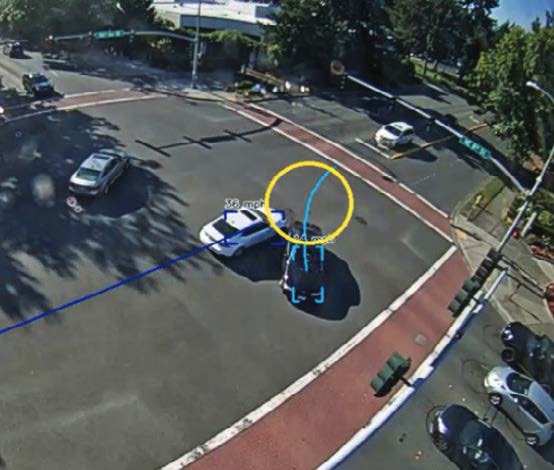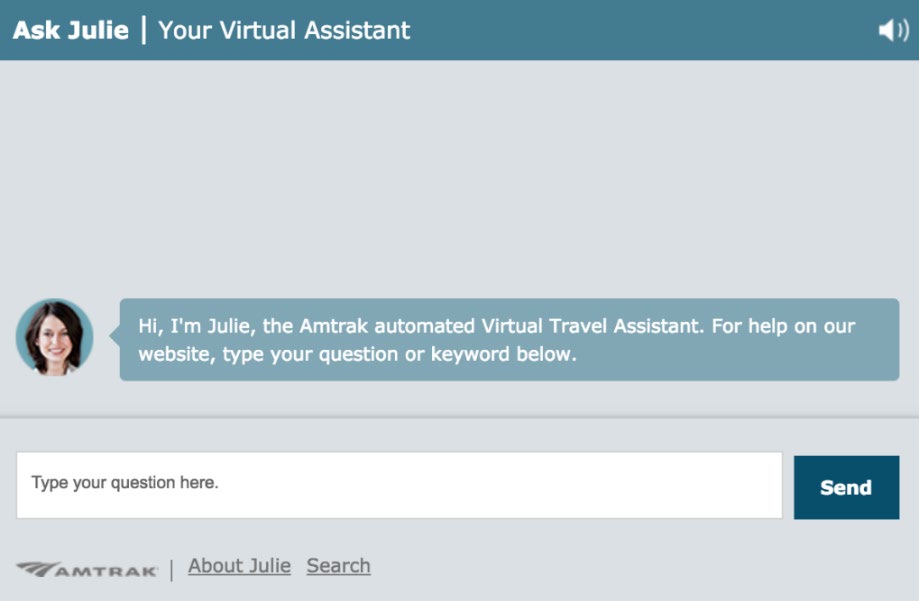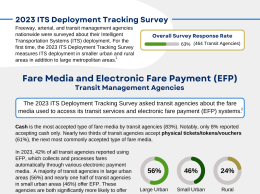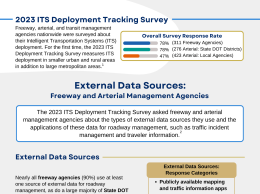2021 Executive Briefing
 BRIEFING HIGHLIGHTS
BRIEFING HIGHLIGHTS
- AI for ITS, an emerging technology field, has the potential to enhance the safety, efficiency, and mobility of the transportation system.
- The GAO has outlined a framework for accountability in AI implementations for government agencies.
- The city of Bellevue, WA used AI machine vision to analyze video data and understand factors that lead to crashes.
Introduction
Artificial Intelligence (AI) is revolutionizing every walk of life, allowing machines to learn from experience, adapt, and perform tasks that have historically required human cognition. Factors that have led to increased attention to AI in the last decade include increased computing power, mass data collection and storage, and innovations in AI algorithms, including Machine Learning (ML), a sub-field of AI that uses data to improve performance with experience [1].
In October 2016, the National Science and Technology Council published The National Artificial Intelligence Research and Development Strategic Plan, which outlines how federal agencies should prioritize federally funded research and development (R&D) in AI [2]. In February 2019, the White House issued Executive Order 13859, Maintaining American Leadership in Artificial Intelligence, which outlines federal government principles and objectives and prioritized AI as a key R&D area in the federal government [3].
The U.S. Department of Transportation (USDOT) Intelligent Transportation Systems (ITS) Joint Program Office (JPO) Strategic Plan 2020-2025 mentions that ML and AI “have the potential to transform ITS at every level of implementation” [4]. In 2020, the ITS JPO kicked off the AI for ITS Program with the mission of identifying, developing, implementing, evaluating, and coordinating technology and policy research to advance the integration of AI into the transportation system for safer and efficient movement of people and goods. The goal of the program is to cost effectively build and deploy AI for ITS capabilities in real-world modal use [5].
A few examples where AI is already being applied to ITS include [6]:
- Multimodal Decision Support. AI can support decision making to optimize the performance of a multimodal transportation system. For example, the Delaware Department of Transportation (DelDOT), in coordination with partners and grant funding from U.S. DOT, is developing an AI-powered Integrated Transportation Management System with expected outcomes including a predictive and adaptive self-monitoring transportation system, automated operation and enhanced decision making, reduced incident detection time, and more [7].
- Multimodal Intelligent Traffic Signal Systems. AI can be used to service all modes of transportation by predicting vehicle and pedestrian arrivals, queues, and delays. For example, Utah DOT (UDOT) entered a contract in late 2019 with an AI company to develop a real-time traffic signal optimization system based on ML and UDOT’s Automated Traffic Signal Performance Measures.6 Additionally, the City of Pittsburgh, with partial funding through the Federal Highway Administration (FHWA) Advanced Transportation and Congestion Management Technologies Deployment (ATCMTD) program, and its partners have deployed Scalable Urban Traffic Control (Surtrac), a decentralized and scalable AI-powered signal control system [8].
Proactive Incident Management. AI techniques can be used to detect and predict incidents based on data from sensors, videos and images, CV messages, and other data sources. The systems can quickly analyze this data, detect patterns, and identify certain objects in the surrounding with high accuracy. For example, several state and local DOTs in Nevada, Florida, and Iowa have begun deploying AI technologies for incident detection. These agencies expected AI to improve their ability to react to incidents by detecting them sooner and more reliably in locations where traditional detection is lacking, such as in rural areas with limited cellular coverage [9].
Factors that have led to increased attention to AI in the last decade include increased computing power, mass data collection and storage, and innovations in AI algorithms. - Asset Management and Maintenance. An important subset of machine vision applications, AI systems can address the operation, maintenance, and improvement of physical assets to achieve a desired state of good repair over the lifecycle of assets at economical costs [1].
Benefits
AI encompasses a wide range of concepts creating a challenge for identification of benefits. Additionally, public sector agencies may procure AI solutions from software vendors that are branded as “AI” even if the actual AI components of these solutions are unclear. Finally, many AI for ITS projects are only in the conceptual, R&D, and prototype phases, so their benefits and costs remain to be seen. However, an increasing number of studies cite AI-related benefits in ITS. While few of these studies have cited the benefits of physical deployments of AI in ITS, many have cited benefits for simulated deployments. Below is a summary of a few of the potential benefits to ITS:
Safety. AI has the potential to improve transportation system safety through enhanced incident response and prediction, improved video detection to avoid pedestrian-vehicle conflicts, and better monitoring and management of assets to keep infrastructure in proper condition. As part of the U.S. DOT Safety Data Initiative, University of Central Florida built a real-time crash risk visualization tool for traffic safety management that predicts road segments at the greatest risk of crashes and suggests mitigation strategies in real time [10].
Efficiency. Using large amounts of data and deep learning algorithms, AI applications can identify strategies that optimize systems and economically allocate scare resources. The Virginia Department of Transportation, with funding from the FHWA ATCMTD program, is planning on deploying an application to predict parking availability [11].
Mobility. AI for ITS has the potential to improve mobility for multimodal transportation users. By equipping transportation systems operators with big-data driven insights, it has the potential to reduce congestion, increase arterial speeds, reduce maximum queue lengths at intersections, recommend faster routes for travelers using real time data, and more [1]. More specific quantified potential benefits are shown below in Table 1.
| Agency/Location | AI Use | Potential Benefits |
|---|---|---|
| Nevada DOT, Nevada Highway Patrol, and Regional Transportation Commission | Used AI software to alleviate traffic crashes at dangerous intersections with higher-than average crash rates in Southern Nevada. | Contributed to a 17 percent reduction in primary crashes (2020-01507). |
| Florida DOT | Implemented AI-powered Adaptive Signal Control Technology in eight Florida cities. | Resulted in an overall travel time reduction of 9.36 percent for eight corridors (2021-01579). |
| City of Bellevue, WA | Used video-based AI processing of traffic camera footage to analyze traffic volume, road user speed, and near-crash event data. | Video-based monitoring is an effective method to obtain conflict data. Unlike traditional traffic safety evaluation methods, video-based monitoring is detailed enough to identify near crashes, classify road user types and their movements, and detect other lane violations (2022-01617). |
| Gachon University of South Korea | Developed a traffic flow prediction algorithm that uses deep Q-network reinforcement learning to minimize vehicle wait times in a simulated arterial network. | Potential to make traffic signals up to 75 percent more efficient (2020-01435). |
Best Practices
In June 2021, the Government Accountability Office (GAO) released their report, Artificial Intelligence: An Accountability Framework for Federal Agencies and Other Entities [12]. The report outlines key accountability practices— centered around the four principles of governance, data, performance, and monitoring—for federal use of AI. A few key practices for each framework principle include:
- Governance. Define clear goals, roles, and responsibilities. Demonstrate values and principles to foster trust. Develop a competent workforce with different perspectives to mitigate risks. Establish technical specifications to ensure the AI system meets its intended purpose and follows relevant laws, regulations, standards and guidance. Promote transparency by enabling outside stakeholders to access system information.
- Data. Document sources and origins of data, ensure reliability of data, and assess data attributes, variables, and augmentation for appropriateness. Assess dependencies of data streams that go into AI systems and identify biases and security risks.
- Performance. Define metrics and assess the performance of AI systems. Document methods for assessment, performance metrics, and outcomes. Identify potential biases and define and develop procedures for human supervision of the system. Catalog model and non-model components of the system.
- Monitoring. Develop plans for continuous or scheduled monitoring of the system; document results and corrective actions taken. Assess the ongoing utility of the AI system to ensure relevance and understand conditions where the system may or may not be expanded beyond its current use case.
Case Studies

City of Bellevue advanced video analytics: video-based network-wide conflict and speed analysis.
As part of their Vision Zero project, the city of Bellevue, Washington aims to eliminate fatalities and seriousinjury crashes by 2030. One part of this strategy involves identifying which intersections are most problematic in terms of crashes; however, Bellevue did not have the volume or granularity of data to accurately identify intersections that required immediate attention. Traditional methods were unable to identify near-crashes, classify road user types, or detect speeding infractions and lane violations [13].
To improve their data collection and analysis capabilities, the city partnered with private industry to install 360-degree, high-definition traffic cameras at 40 intersections. These intersections were chosen from a various group of intersections that differ in geographic location, land use, population density, and road geometry. Using this high-quality video feed and proprietary AI software for advanced video analytics, they identified traffic volumes, road user speeds, and near-crash traffic conflict indicators. Over the course of the study, around 5,000 hours of footage was taken, and 8.25 million road user observations were collected.
Using the data collected and analyzed by AI, the city published results in three reports: conflict analysis; speed and speeding analysis; and conflict, speeding, and crash correlation. Because of the volume, variety, and granularity of data they were able to collect, statistical relationships were able to be modeled that allow practitioners to not only identify the most problematic intersections but better understand the nature of site-specific issues and contributing factors to crashes.
Amtrak’s Interactive Voice Response (IVR) Application “Julie.”
Starting back in 2000, Amtrak was looking for a method to effectively manage the more than 84,000 daily passenger calls they received with customers’ questions about schedules, fares, train status and reservations. To complicate the problem, the solution also needed to be able to understand an extensive grammar base, interpreting references to Amtrak’s 500-plus destinations across 46 states [14].

Using an AI-based IVR application named “Julie,” Amtrak was able to create a virtual assistant to help users with their questions and requests. Julie takes in a customer’s request over the phone in natural conversational language, interprets the request, and provides a concise reply in an automated voice. AI allows Julie to filter through millions of possible input options to understand the request and then review possible replies to come up with the correct response in seconds.
Julie now answers about 20 million calls per year, or an average of about 55,000 calls per day, peaking at around 95,000 calls per day during the most active periods. The application solely handles about 25 percent of all phone calls and completes more calls in a single day than one human customer service representative typically handles in a year. Julie also now functions as a chatbot via Amtrak’s website and through text messages.
References
- M. Vasudevan, H. Townsend, T. N. Dang, A. O'Hara, C. Burnier, and K. Ozbay, “Identifying Real-World Transportation Applications Using Artificial Intelligence (AI): Summary of Potential Application of AI in Transportation.,” U.S. Department of Transportation, Intelligent Transportation Systems (ITS) Joint Program Office (JPO), 2020. [Online]. Available: https://rosap.ntl.bts.gov/view/dot/50651.
- “Exploratory Advanced Research Program The Role of Artificial Intelligence and Machine Learning in Federally Supported Surface Transportation Initiatives,” Federal Highway Administration, 2018. [Online]. Available: https://www.fhwa.dot.gov/publications/research/ear/18066/18066.pdf.
- “Maintaining American Leadership in Artificial Intelligence. ,” Executive Office of the President, 2019. [Online]. Available: https://www.federalregister.gov/documents/2019/02/14/2019-02544/maintainingamerican-leadership-in-artificial-intelligence.
- S. Chan-Edmiston, S. Fischer, S. Sloan, and M. Wong, “Intelligent Transportation Systems Joint Program Office: Strategic Plan 2020-2025,” U.S. DOT ITS-JPO, 2020. [Online]. Available: https://www.its.dot.gov/stratplan2020/ITSJPO_StrategicPlan_2020-2025.pdf.
- J. Walker, “Artificial Intelligence for Intelligent Transportation Systems: Program Overview Webinar,” U.S. DOT ITS-JPO, 2021. [Online]. Available: https://www.its.dot.gov/research_areas/emerging_tech/pdf/Webinar1_OverviewAI_ITS%20Program_FINA L.pdf
- M. Vasudevan, H. Townsend, E. Schweikert, K. Wunderlich, C. Burnier, B. Hammit, D. Gettman, and K. Ozbay, “Identifying Real-World Transportation Applications Using Artificial Intelligence (AI): Real-World AI Scenarios in Transportation for Possible Deployment.,” U.S. DOT ITS-JPO, 2020. [Online]. Available: https://rosap.ntl.bts.gov/view/dot/50752
- G. Donaldson, “Emerging Technologies in Transportation Management Webinar,” Delaware DOT, I-95 Coalition, 2020. [Online]. Available: https://tetcoalition.org/wp-content/uploads/2020/08/I-95CC-TSMOEmerge-Tech-in-TM-30jan2020-final.pdf
- “Surtrac for the People: Upgrading the Surtrac Pittsburgh Deployment to Incorporate Pedestrian Friendly Extensions and Remote Monitoring Advances,” U.S. Department of Transportation, 2018. [Online]. Available: https://www.transportation.gov/utc/surtrac-people-upgrading-surtrac-pittsburgh-deploymentincorporate-pedestrian-friendly
- D. Gettman, “Raising Awareness of Artificial Intelligence for Transportation Systems Management and Operations,” U.S. DOT FHWA, 2019. [Online]. Available: https://ops.fhwa.dot.gov/publications/fhwahop19052/fhwahop19052.pdf
- “Safety Data Initiative Projects,” U.S. Department of Transportation, 2021. [Online]. Available: https://www.transportation.gov/SafetyDataInitiative/Pilots
- “VDOT Awarded More than $4.5 Million in Federal Grants,” Virginia Department of Transportation, 2020. [Online]. Available: https://www.virginiadot.org/newsroom/statewide/2020/vdot-awarded-morethan-45-million-in-federal-grants7-28-2020.asp
- “Artificial Intelligence: An Accountability Framework for Federal Agencies and Other Entities,” Government Accountability Office, 2021. [Online]. Available: https://www.gao.gov/products/gao-21-519sp
- “Accelerating Vision Zero with Advanced Video Analytics: Video-based Network-wide Conflict and Speed Analysis,” National Operations Center of Excellence, 2021. [Online]. Available: https://transportationops.org/case-studies/accelerating-vision-zero-advanced-video-analytics-video-basednetwork-wide-conflict-and
- “Amtrak's Julie gets callers on board,” Nuance Communications, Inc., 2016. [Online]. Available: https://www.nuance.com/content/dam/nuance/en_au/collateral/enterprise/case-study/cs-amtrak-enus.pdf



